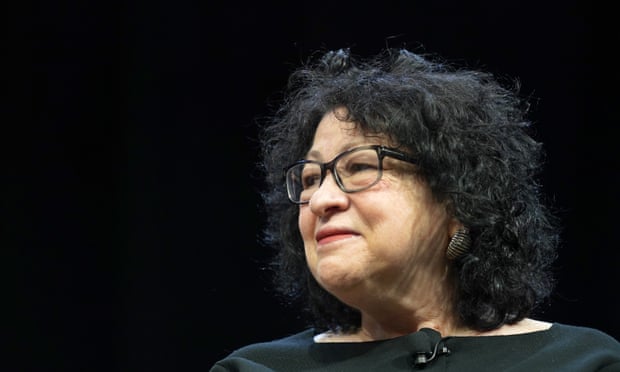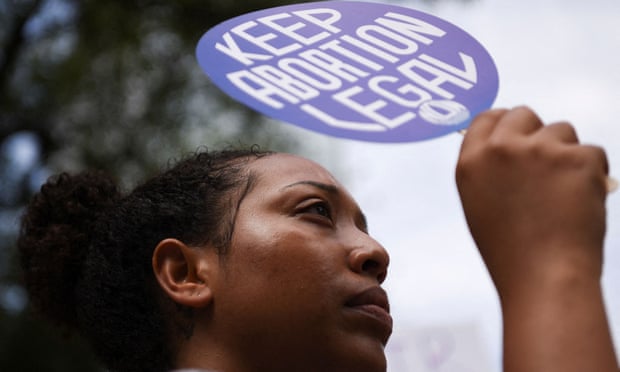What the liberal justices’ scorching dissent reveals about the US supreme court
"Opinions from Breyer, Kagan and Sotomayor send stark warning about increasingly radical court abandoning long-held principles

The US supreme court’s decision to overturn Roe v Wade, ending nearly 50 years of federal protections for abortion access, was “catastrophic”. The ruling amounted to a “curtailment of women’s rights, and of their status as free and equal citizens”. The drastic decision “undermines the court’s legitimacy”, and the consequences of it will set off an “upheaval in … society”.
Those are voices from the supreme court itself: the words of its three liberal justices – Stephen Breyer, Elena Kagan and Sonia Sotomayor – in their scorching and thorough joint dissenting opinion on a decision by their body which has fundamentally altered the lives of millions of Americans.
In the opinion, the three liberal justices repeatedly warn of the devastating impact of the end of Roe, while emphasizing that the majority’s ruling breaks with core tenets of court procedure.
That criticism echoes throughout the liberals’ other dissenting opinions of the court’s most recent term, which wrapped up late last month, revealing that America’s top legal body – with huge power over American life – is deeply split. And while huge attention has been paid to the rulings of the rightwing majority, the liberal dissents also offer an insight into the state of America – and a scary warning for its future.
The court’s last term was one of the most consequential in recent memory, as the conservative majority handed down major decisions on everything from abortion rights to gun restrictions and climate policy. Those decisions were often met with a dissenting opinion from the court’s liberal justices, who voiced alarm about the direction and the velocity of the conservatives’ rulings.
Taken together, the dissents written by the three liberal justices this term send a clear warning about an increasingly radical court that is abandoning long-held principles and even the facts of a case to enact an extreme conservative agenda in America.
While supreme court opinions can frequently become mired in legalese that is incomprehensible to the average reader, the wording of the liberals’ dissents is often simple and direct. The opinions can read like a desperate attempt to reach beyond the court’s standard audience of legal experts to speak to the millions of people who will feel the impact of these rulings.
“Today, the court leads us to a place where separation of church and state becomes a constitutional violation,” Sotomayor wrote in her dissenting opinion to conservatives’ decision in Carson v Makin. She concluded: “With growing concern for where this court will lead us next, I respectfully dissent.”
‘A culture of argument’
Dissenting opinions are a relatively unique quirk of the US legal system. A handful of other countries, including the UK, give judges the opportunity to register their disagreement with a decision, but most do not.
Paul Schiff Berman, a professor at George Washington University Law School, said dissenting opinions help foster “a culture of argument” around America’s laws.
“It reflects the idea that law is not just a set of rules but is an argument about how to put society together,” Berman said. “Even a view that is not going to be the law of the land at a particular moment in history nevertheless gets articulated in the public arena, so people can see that there is a debate going on that they can be part of and that these things change over time.”
That “culture of argument” was alive and well at the supreme court this term, as the liberal justices frequently excoriated the decisions delivered by their conservative colleagues. In one particularly biting dissent, Kagan predicted that the court’s decision in Federal Election Commission v Ted Cruz for Senate would “only bring this country’s political system into further disrepute”.

“In discarding the statute, the court fuels non-public-serving, self-interested governance,” Kagan writes. “It injures the integrity, both actual and apparent, of the political process. I respectfully dissent.”
But while fiery dissents are nothing new, the opinions filed by liberals this term stand out for their sweeping criticism of the rulings, which extends far beyond the legal philosophy underpinning conservatives’ decisions.
In a number of instances, the liberals take issue with the majority’s presentation of the facts of a case.
That dynamic was evident in Kennedy v Bremerton school district, a case involving a football coach who sued his public school district over the right to publicly pray after games. When Justice Neil Gorsuch delivered the majority’s decision, he said the coach, Joseph Kennedy, had “lost his job as a high school football coach because he knelt at midfield after games to offer a quiet prayer of thanks”.
In her dissent, Sotomayor notes that Kennedy had not actually been fired over his actions, and she even included photos to contradict Gorsuch’s characterization of the coach’s “quiet prayer of thanks”. One photo shows Kennedy kneeling at the 50-yard line of the football field, surrounded by dozens of players and holding a helmet aloft.
“As someone who has followed that case, the way that the majority described the facts at hand were so far from reality,” said Lindsay Langholz, director of policy and program at the progressive group American Constitution Society. “It struck me as [Sotomayor] using whatever tool was available to her to really underline just how egregious the manipulation of the facts was in that case.”
The liberal justices’ outrage over their conservative colleagues’ presentation of facts is evident in their dissent to Dobbs v Jackson Women’s Health, which reversed the nearly 50-year-old precedent of Roe.
Writing for the majority, Justice Samuel Alito claims that it is extremely difficult for a court to ascertain what, if any, level of reliance Americans have on the federal right to abortion access. He specifically criticizes the court’s ruling in Casey v Pennsylvania, which upheld Roe partly on the reasoning that Americans had organized their intimate relationships based off their reliance on the availability of abortion services.
“Today the majority refuses to face the facts,” the liberals write in their dissent. “By characterizing Casey’s reliance arguments as ‘generalized assertions about the national psyche’ … it reveals how little it knows or cares about women’s lives or about the suffering its decision will cause.”
Throughout the term, the liberal justices repeatedly supported their dissenting opinions by acknowledging the immense impact of conservatives’ rulings. In the Dobbs dissent, the liberals warn that many people who are unable to terminate a pregnancy will instead “turn in desperation to illegal and unsafe abortions”.
“They may lose not just their freedom, but their lives,” they write.
Breyer similarly begins his dissenting opinion in New York State Rifle & Pistol Association v Bruen, which struck down a New York law strictly regulating the use of firearms outside the home, by noting that 45,222 Americans were killed by guns in 2020.
“In my view, when courts interpret the second amendment, it is constitutionally proper, indeed often necessary, for them to consider the serious dangers and consequences of gun violence that lead states to regulate firearms,” Breyer writes.
Instead of engaging with the potential ramifications of their rulings, the court’s conservative justices often deliberately avoid such questions. Alito writes in his Dobbs decision, “We do not pretend to know how our political system or society will respond to today’s decision overruling Roe and Casey. And even if we could foresee what will happen, we would have no authority to let that knowledge influence our decision.”
The liberals see the majority’s refusal to acknowledge the certainty of abortion bans, given that 13 states already had “trigger laws” to outlaw the procedure if Roe was overturned, as vindication for their position.
“Closing our eyes to the suffering today’s decision will impose will not make that suffering disappear,” the liberals write. “The majority’s refusal even to consider the life-altering consequences of reversing Roe and Casey is a stunning indictment of its decision.”
‘It undermines the court’s legitimacy’
Perhaps the most striking aspect of the liberals’ dissenting opinions this term is the justices’ repeated warnings about attacks on the institutional integrity of the court.
In her dissenting opinion in West Virginia v Environmental Protection Agency, Kagan warns conservatives’ decision to severely limit the federal government’s ability to curtail greenhouse gas emissions threatens the separation of powers.
“Let’s say the obvious: the stakes here are high,” Kagan writes. “The court appoints itself – instead of Congress or the expert agency – the decision-maker on climate policy. I cannot think of many things more frightening. Respectfully, I dissent.”
Berman said warnings like Kagan’s reflect the distinctive nature of this term’s dissenting opinions. “They are sounding an alarm – not just about a difference of judicial philosophy in a particular case, but about the radical attack on settled expectations and the ongoing legitimacy of the supreme court itself,” Berman said.
That theme reverberates throughout the liberals’ dissent in Dobbs, which they conclude by warning that the court’s decision to overturn the key precedent of Roe “breaches a core rule-of-law principle” and “places in jeopardy other rights, from contraception to same-sex intimacy and marriage”.
“It undermines the court’s legitimacy,” the liberals write. “In overruling Roe and Casey, this court betrays its guiding principles. With sorrow–for this court, but more, for the many millions of American women who have today lost a fundamental constitutional protection–we dissent.”
Olatunde Johnson, a professor at Columbia Law School, said the closing lines of the Dobbs dissent stand out to her because of the liberals’ bleak assessment of the court.
“This is saying, not only is this violating the notion of rule of law and stability. It’s not just that I disagree with you; it’s that you are doing something out of the bounds of constitutional lawmaking and that it threatens the way we’re going to be seen by the larger public,” Johnson said. “That’s really strong language.”
But if the liberals’ dissenting opinions paint a dire picture about the state of American democracy, they could also offer glimmers of hope for those who are distraught by the court’s rulings this term.
After all, dissenting opinions have previously paved the way for a reconsideration of the court’s past decisions.
Perhaps most famously, Justice John Harlan’s lone dissent in Plessy v Ferguson, which enshrined the racist doctrine of “separate but equal” into American law, was later cited by the lawyers who advocated for its reversal in Brown v Board of Education.
“It certainly gives me hope, and I think it also gives me a sense of comfort that there are at least three justices on the court who see what’s happening,” Langholz said. “If we can build on that coalition within the court, maybe we can get back to a place where the court is not ruling by fiat.”
No comments:
Post a Comment